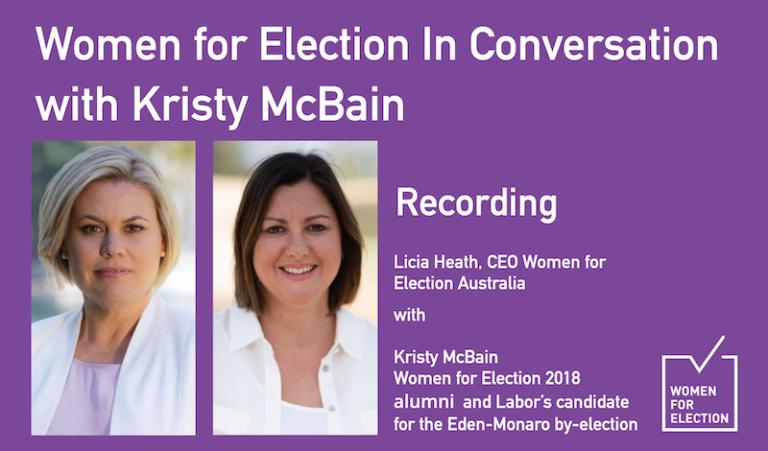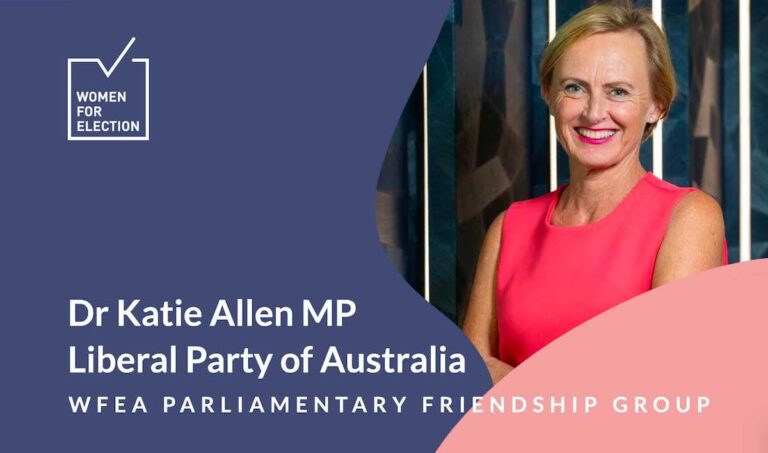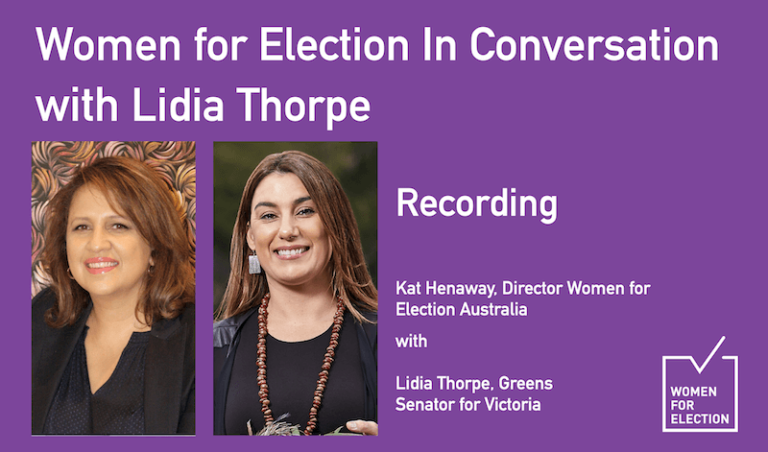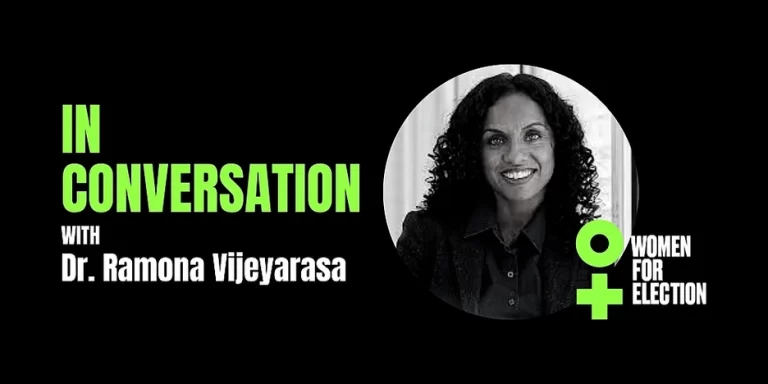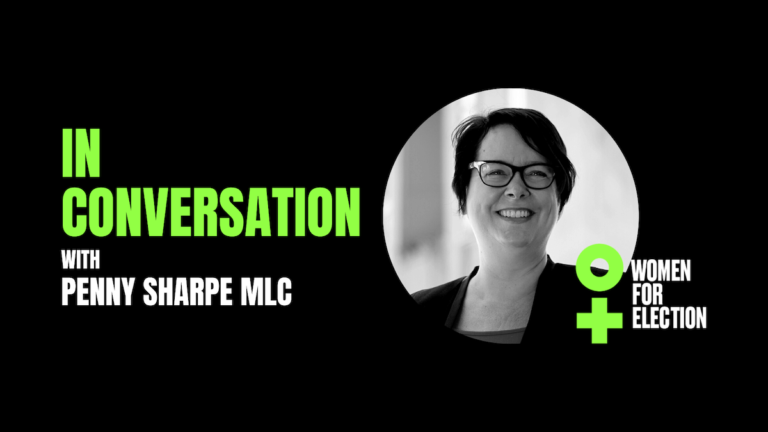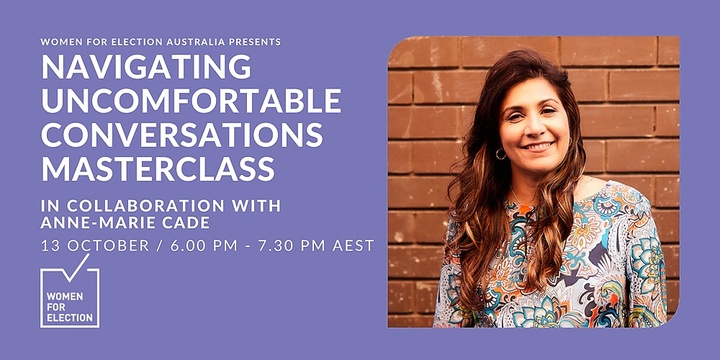Research Conducted by Solai Valliappan: Australian Parliamentarians & Diversity 1996-2022
Article by Kali Goldstone
The need to have a representative democracy, one where the members of our parliaments truly reflect the communities they govern, is rightfully being discussed post the results of the 2022 Federal election. The 47th Federal Parliament is the most culturally diverse in Australia’s history. But it still doesn’t reflect the population it represents. Women, who make up 51% of the population, shockingly are still a minority group in our House of Representatives.
Whilst gains have been made in the proportion of Federal women representatives, now 38% of the House of Representatives and 57% of the Senate, women are still under-represented at every level of Government in Australia. Women make up 39% of our state and territory assemblies, 38% of our Federal MPs and Senators and 43.8% of Councillors across the country.
58 women took their seats in the House of Representatives (also known as the lower house), including 19 new female MPs. Six of those first-term women MPs are Labor members, bringing their House representation to 35, while the Liberal party lost four women, meaning just nine women are sitting on their benches.
Despite the influx of new MPs from diverse backgrounds, Australia still lags behind many similar multicultural countries in terms of political representation.
Australia does far worse than Canada or New Zealand on comparable metrics despite having similar demographics.
- In New Zealand, there are 16.8% of MPs that come from a diverse background.
- In Canada, it is 15.7% of elected MPs.
- In Australia, it is 6.6% of MPs.
Even the United Kingdom is notably ahead of us at 10.5% when you look at their rates of Black and Minority Ethnic representation in the House of Commons.
Although 23% of Australians claim a non-European ancestry, just 6.6% – or 15 out of the 227 MPs – have overseas non-European backgrounds. Only 4.4% of MPs in our parliament have Asian heritage, compared with 18% of the Australian population at large.
Solai Valliappan, a Tech investor with an actuarial background, got in touch with Women for Election to share her data analysis from the last ten federal election results from 1996-2022. What she found was fascinating:
WOMEN:
In the House of Representatives, the number of women more than doubled in 10 elections.
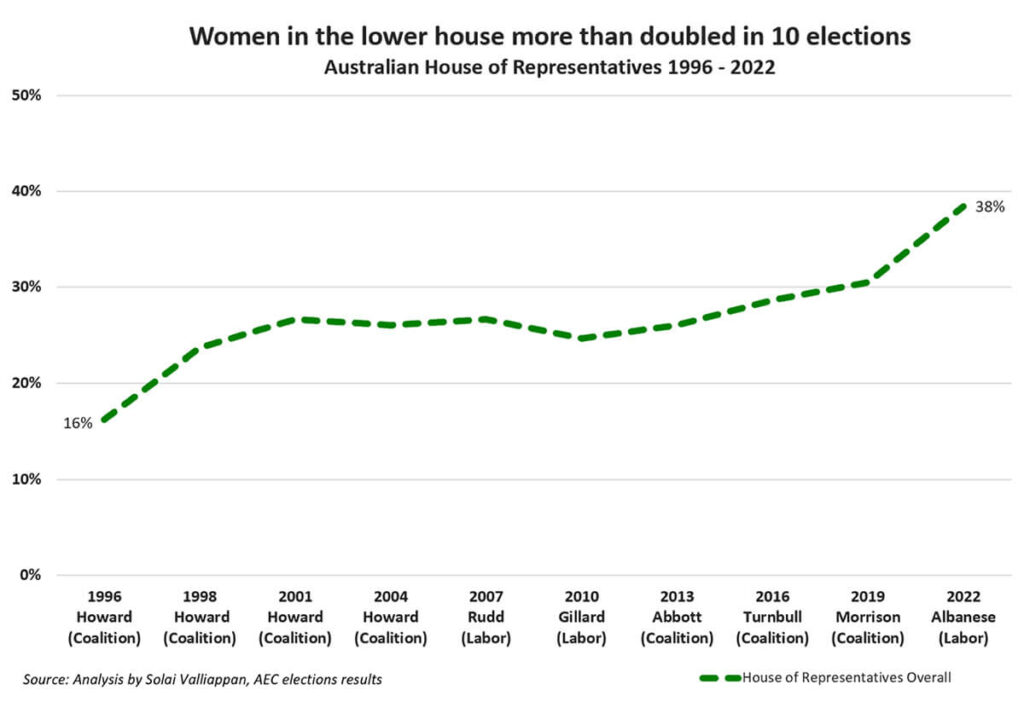
Overall, the number of women in the House of Representatives has more than doubled from 16% in 1996 to 38% in 2022 (i.e. from 1 in 6 to >1 in 3 elected members).
Women now comprise 38 per cent of the chamber in the new parliament – the highest ever proportion on record – after 58 women were elected to the lower house, including 19 first-term MPs.
When looking at the proportion of women in the House of Representatives by political parties it’s wonderful to see that this has increased across the political parties.
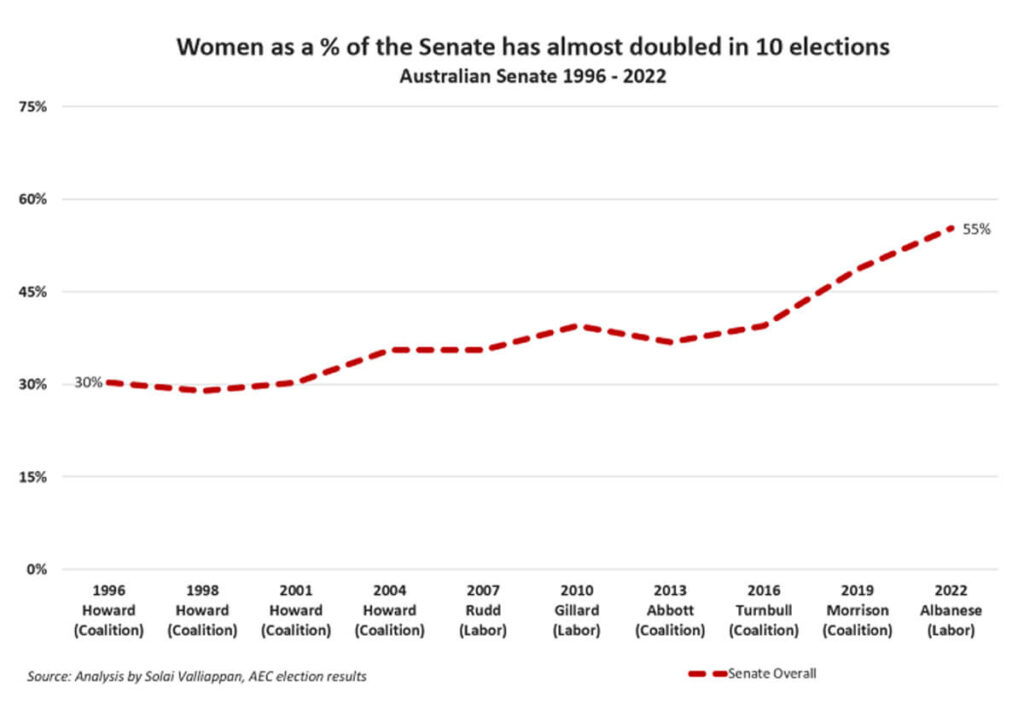
Overall, the number of women in the Senate has almost doubled from 30% in 1996 to 55% in 2022. (i.e., from 1 in 3 to > 1 in 2 senators). This trend is similar to the House of Representatives increasing from 16% in 1996 to 38% in 2022.
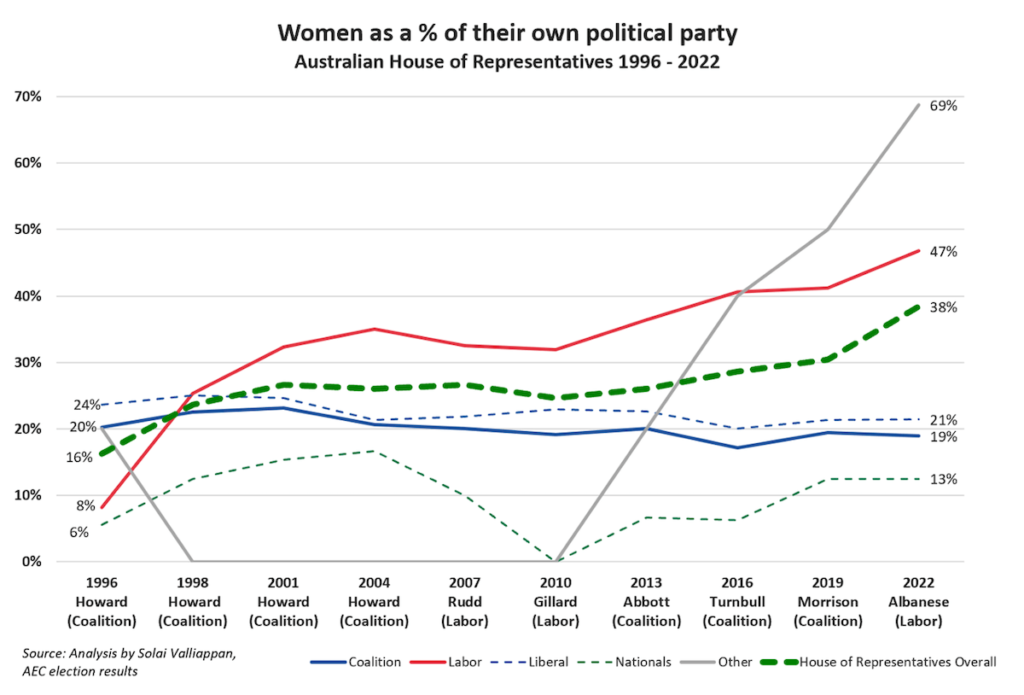
The increase has been primarily driven by the Labor party which introduced gender quotas under the Keating Government in 1994. The initial aim was to ensure that 35 per cent of ALP’s winnable seats at all elections would be filled by women by 2002. The target is now 50 per cent by 2025, but that’s not just for winnable seats, it’s for party positions across the board. This graph shows that Labor is on track to meet its 2025 target in the House of Representatives.
The number of women jumped from 8% in 1996 to 47% in 2022 (i.e., from 1 in 12 to almost 1 in 2 elected Labor members being women) as seen above.
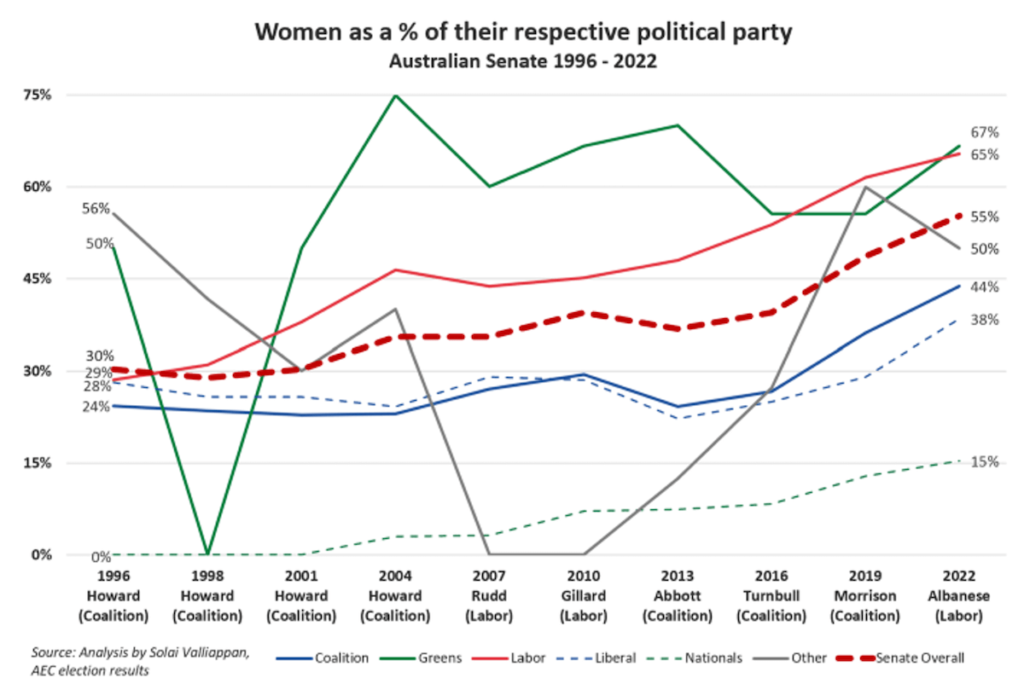
Similar to the House of Representatives, the proportion of women in the Senate by political party has increased across the board. This has been driven by both major parties:
- The Coalition has almost doubled from 24% in 1996 to 44% in 2022.
- The Labor party has increased by more than double from 29% to 65%. The quota target for the Labor party of ‘women filling 50% of seats by 2025’has been achieved in the Senate.
- The Greens party and ‘Other’ has majority women — 50% or greater.
BIPOC, BIWOC and First Nations elected members:
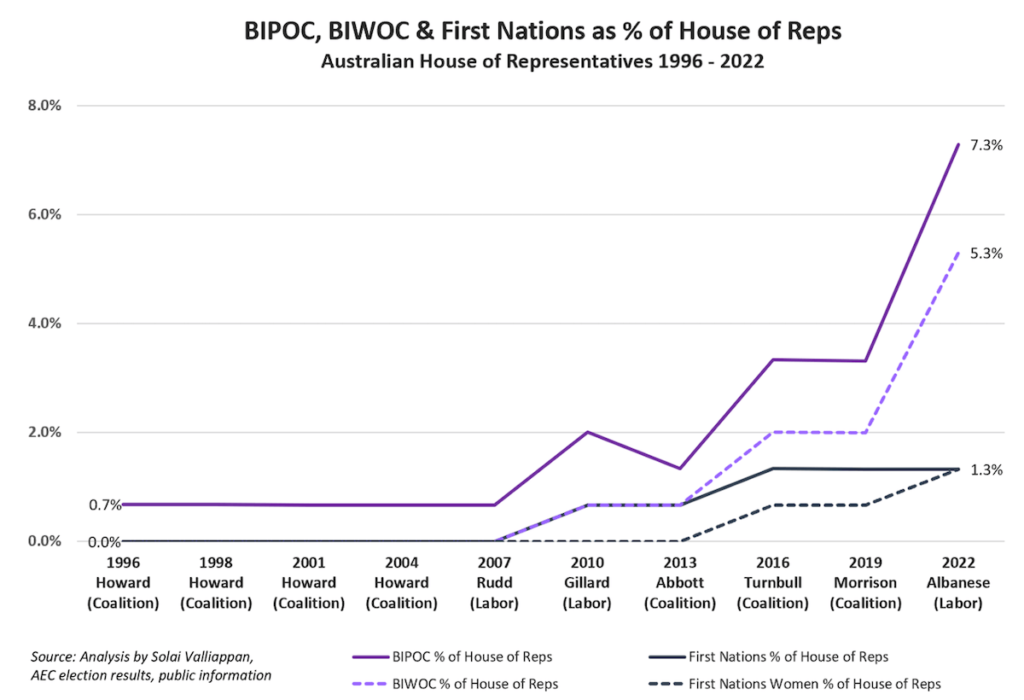
Looking at BIPOC, BIWOC and First Nations elected members were analysed using publicly available information/self-identification. There’s been quite an uptick in the last few elections, however, this is from an extremely low base of zero/almost zero.
What this analysis shows is that if there’s an elected person of colour in the House of Representatives there’s a 70% chance, they’re a woman and a 16% chance they’re First Nations. Looking at this data by political party graphically was too noisy over time, but in the most recent election >80% of BIPOC elected members are part of the Labor party.
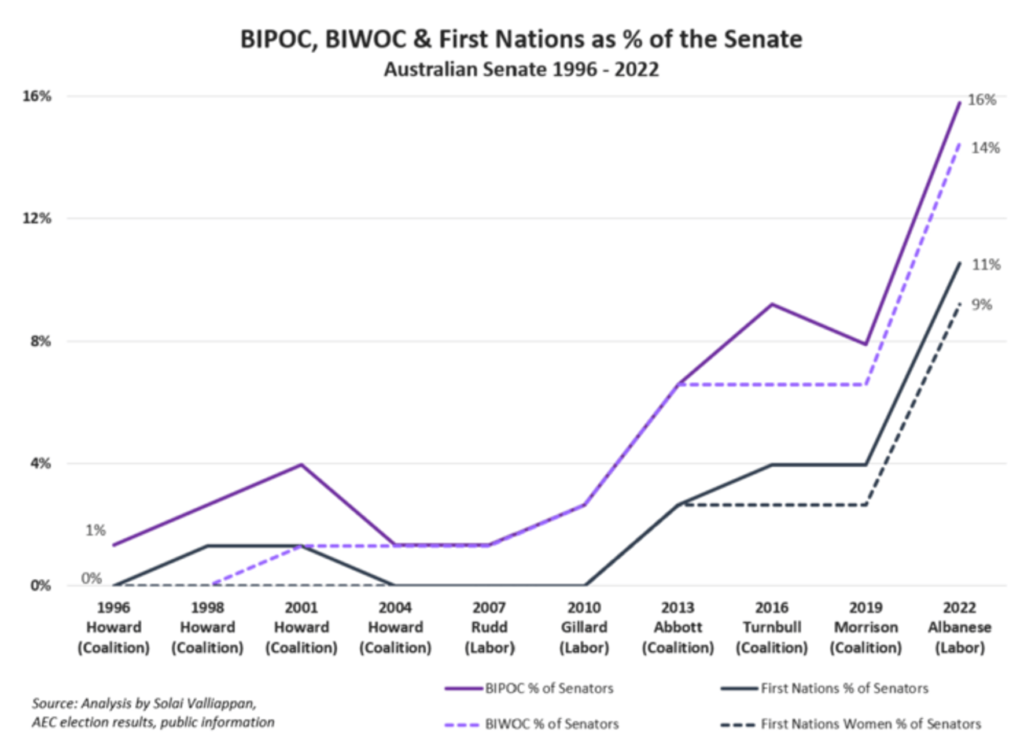
Looking at BIPOC, BIWOC and First Nations senators were analysed using publicly available information/self-identification. The proportion of BIPOC senators (16%) is double that of the House of Representatives (7%).
1 in 6 senators is BIPOC and almost 90% of BIPOC senators are women. 70% of BIPOC senators identify as First Nations and they are most likely to also be a woman. Looking at this data by political party was also too noisy but in the most recent elections >75% of BIPOC senators are members of the Labor party or the Greens.
How does this compare to the Australian population? According to a report from the Australian Human Rights Commission, 21% of Australians have a non-European background and 3% have an Indigenous background.
The House of Representatives is currently 6% non-European background and 1.3% Indigenous background — there’s still some way to reflect the population.
The Senate is currently 5% non-European background and 11% Indigenous background.
While we should celebrate the increase in culturally diverse MPs, only 15 out of 227 (6.6%) federal Parliamentarians have overseas non-European cultural backgrounds.
Our thanks to Solai for sharing her insights with us! At Women for Election, we strongly believe that political education and participation are key aspects of achieving diversity and gender equality in our legislative chambers. We must have more lived, diverse experiences in our Parliament’s to enable the creation and implementation of policy that better supports and reflects the needs of all Australians. The full and active participation of diverse women and men in our legislative chambers is not just a goal in itself, but central to building and sustaining a healthy democracy.
Home » Research Conducted by Solai Valliappan: Australian Parliamentarians & Diversity 1996-2022


